Kalmia: description, planting and care
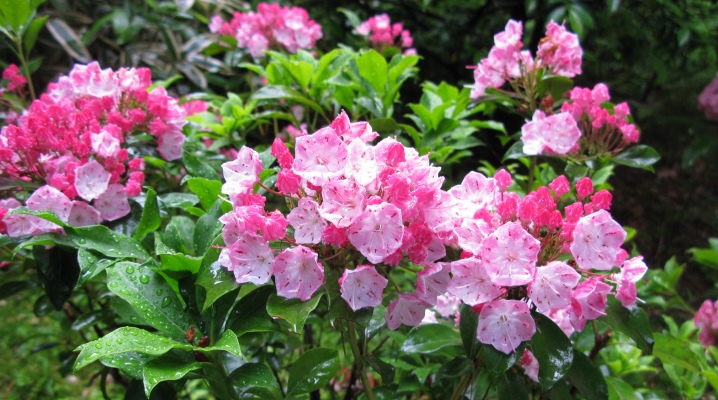
Kalmia is an ornamental shrub that growers appreciate for its spectacular appearance: a lush plant strewn with bright flowers and delicate greenery. Despite this, kalmia is a poisonous plant - its leaves, flowers, pollen and nectar contain dangerous toxins. However, this does not prevent gardeners from growing it to decorate their plots, and landscape designers often use calcium to create flower beds.


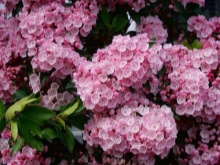
Peculiarities
Kalmia is an evergreen woody plant of the Vereskovy family. It comes from North America. Absolutely all of its varieties are poisonous.
Description of the plant:
- the height can be from 50 to 300 cm, depending on the type;
- leaves 3 to 15 cm long, oblong with a pointed end, arranged spirally along the stem, the lower part of the leaf is light and rough, the upper one is bright green and smooth;
- lush inflorescences, flowers 1-3 cm in diameter, color range - from white-pink to red and purple, bloom in late May - early June.
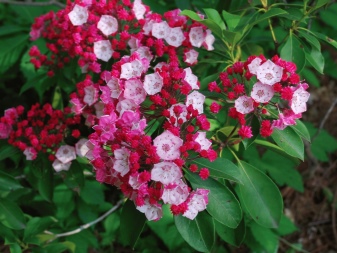
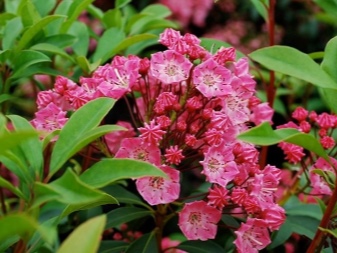
Calmia flowers are pollinated in an unusual way: in the inner part of the still unopened bud, the stamens rest against special recesses on the petals, and when opened, each of them deviates to the side, like the axis of a catapult. If an insect sits on a flower, the stamens springy are released from the depressions in the petals, generously showering it with pollen.
By the end of summer, bolls are formed from the flowers, which open in the fall, scattering a large number of seeds into the soil. Thus, the thickets of kalmias will become thicker every year if they are not periodically thinned out.
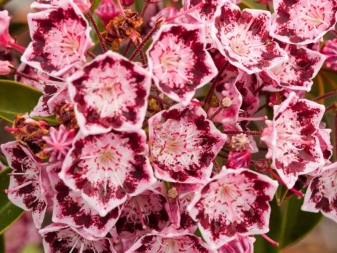
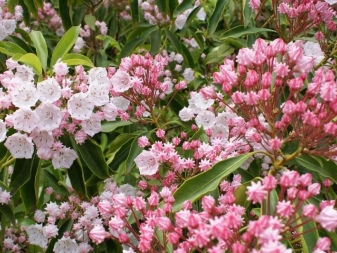
Types and varieties
There are about 10 shrub species in the Kalmia genus. The most popular of them will be listed below, those that can most often be found in gardens and summer cottages.
Many-leaved Kalmia ("bog laurel")
The plant is about 70 cm high and about 60 cm wide. The flowers are purple-pink, not growing in inflorescences, but singly. Bloom in mid-spring. Calmia multifoliate grows slowly. The stems of young plants are purple, as they grow, they turn gray, a solid trunk is formed in the center of the bush. Loves acidic swampy soil.
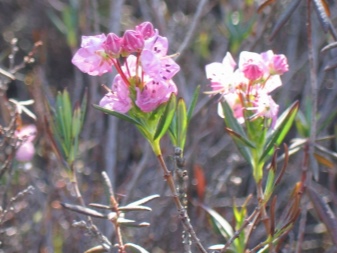
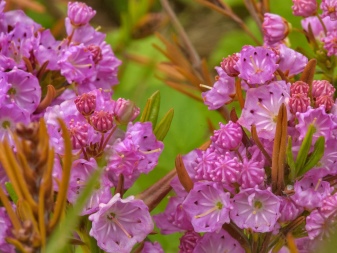
Narrow-leaved Kalmia
Wild shrub up to 1.5 m in height. Selection varieties are much smaller than wild ones - no more than 50 cm in height. At the end of the straight stems, lush flowers with a diameter of about 1 cm bloom, forming umbellate inflorescences. Blooms in June, flowering period is one month. The wild plant has pink flowers, and breeding varieties can combine two shades at once.

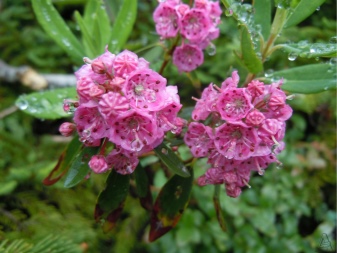
Calmia recumbent
A miniature plant that creeps along the ground. Leaves up to 15 mm long and up to 5 mm wide, juicy, with a thick skin. It blooms mainly in the second half of summer, a group of one inflorescence includes no more than 5-6 white or pink flowers.
It is often used by flower growers to create an alpine slide or vertical flower beds.

"Elf"
A compact ornamental bush no more than 80 cm high. Large flowers make up a lush inflorescence. Blooms in late spring - early summer. The buds are bright pink. As they unfold, the flowers turn white with a pink edging and the same pattern in the center. It is characterized by frost resistance (it can withstand temperatures down to -30 ° C).
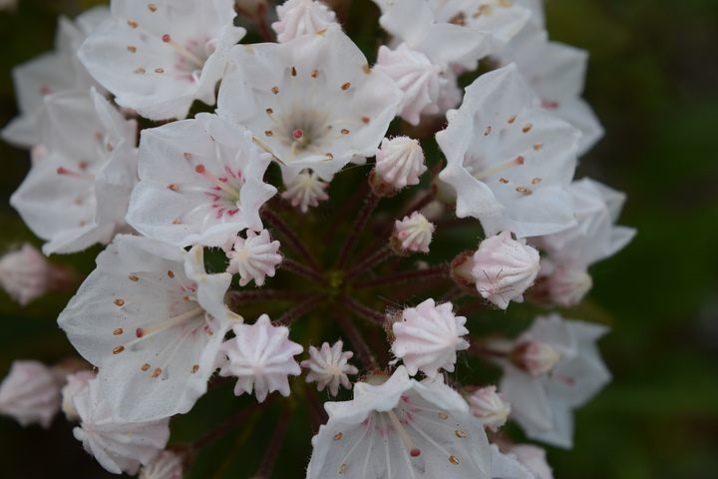
"Kipsake"
One of the most beautiful varieties of kalmias: one plant includes a group of lush inflorescences, each of which contains about 60 bowl-shaped flowers. The flowers are bright purple in the center and pale pink towards the edges. Blooms in late May. The height of one bush is from 50 to 160 cm.
Suitable for growing in the Urals and Siberia (withstands up to 35 ° C frost). Prefers a windless shaded bed.
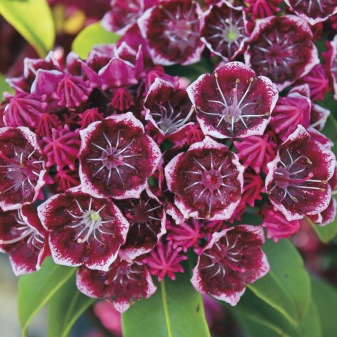

"Beacon"
Large shrub with a height of 1.5 to 3 m with a spreading crown. It develops slowly: every year its height increases by no more than 3-4 cm. One inflorescence contains a group of about 70 flowers ranging from white-pink to purple in color. Blooms from mid-May to mid-June. Prefers loose soil with high acidity. Resistant to frost.
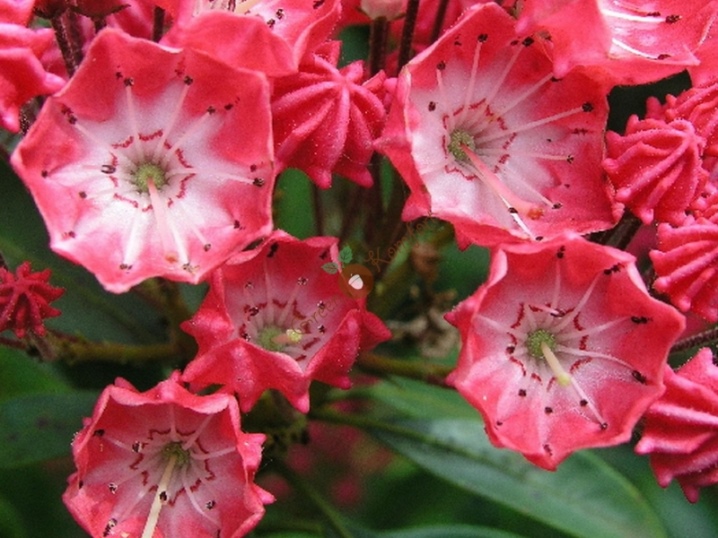
Jens Delight
It is a sprawling bush that can grow up to 1 m in height. The inflorescences are lush with two-colored flowers - inside there is a burgundy ring, and along the edges and in the middle, the petals are painted white. The diameter of one flower is up to 3 cm. It blooms at the end of May. Frost resistant.
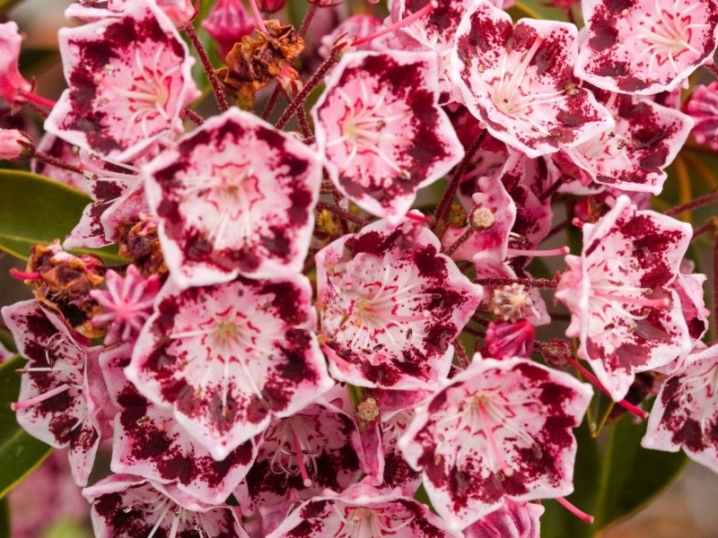
"Tofka"
The most modern variety. Like other varieties, it develops extremely slowly: by the age of ten it can reach a height of no more than 1.5 m. The flowers are cup-shaped with burgundy blotches. Petals with rounded edges and corrugated texture. Feels great in partial shade, in a calm place on acidic fertile soil.
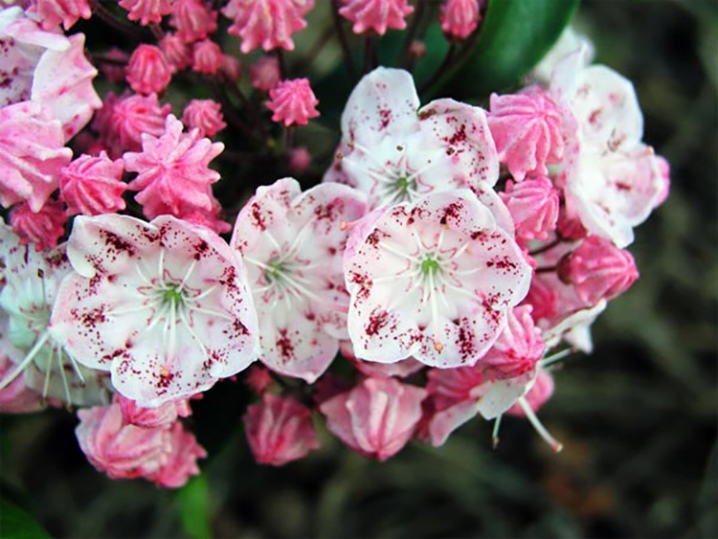
How to plant?
Before planting, you need to choose a suitable place in the garden - it should be a shaded area, closed from the wind. All types of kalmiya prefer loose and fertile soil with high acidity. If the soil is heavy, clayey, it must be mixed with a little peat and leafy soil. It is also important to create a drainage layer if the bed is in a low-lying area. Calmia does not tolerate stagnant water well.
The best time to plant a bush seedling is spring, around mid-April to early May. The step-by-step process of planting in open ground is as follows:
- it is necessary to dig a hole - its depth should be twice the length of the rhizome;
- if necessary, fill a drainage layer on the bottom, you can use small pebbles, coarse sand or brick chips;
- mineral fertilizer must be applied to the depleted soil;
- place the seedling in the center of the hole and cover it with earth;
- thoroughly compact the earth and water the plant.

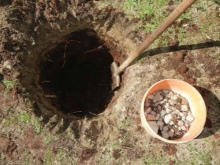
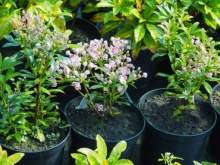
It is recommended to cover the soil with mulch after planting, this will protect it from drying out, prevent weed growth and improve general properties. Bark or sawdust is suitable as mulch.
Almost all types of calmia are suitable for growing in the Moscow region, but in the Urals and Siberia it is better to grow exclusively narrow-leaved calcium, as it withstands frost better. In extremely cold regions, the plant may need additional shelter for the winter.
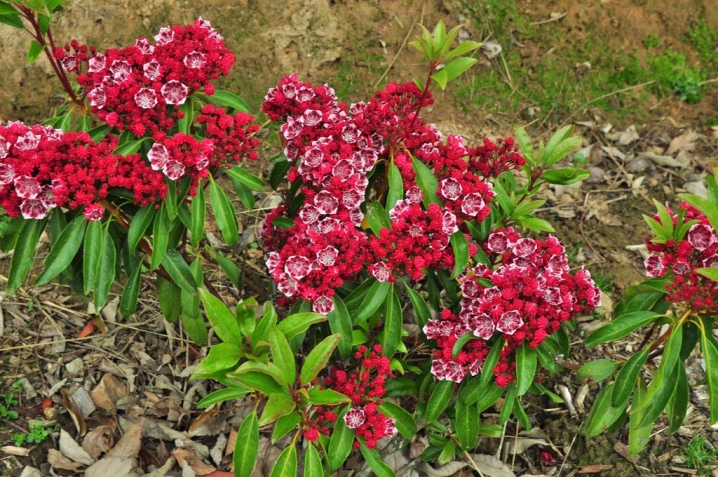
How to take care of it properly?
Calmia care is minimal - 3-4 times from mid-spring to late summer, it is recommended to loosen the soil around the shrub, but this should be done with extreme caution, since the root system of kalmia is superficial, and it can be accidentally damaged with a garden tool.
Watering
The shrub is drought tolerant, but only if it grows in a shaded area. In conditions of a prolonged absence of rain, the plant can be watered a couple of times a month. If it rains heavily at least once every 1-2 weeks, you do not need to water the calcium.
An adult bush will need at least 10 liters of water to replenish its moisture supply.
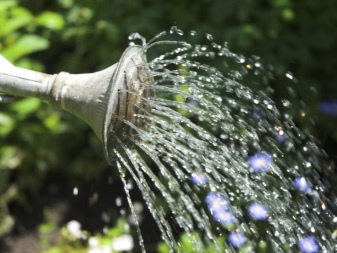
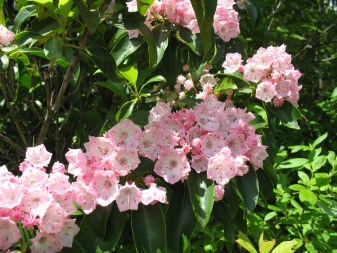
Top dressing
Calcium fertilization is necessary 2-3 times a year, from April to June. In the spring, it is better to fertilize calcium with urea, diluting it at the rate of 35 grams per bucket of water (10 l). During the period of active flowering, organic fertilizers must be applied to the soil. Closer to autumn, granular fertilizer can be scattered under the calmia bush. For this, any universal means for feeding ornamental horticultural crops is suitable.

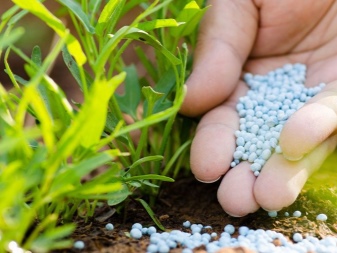
Pruning
In the spring, the bush must be carefully examined and damaged or dry branches removed from it. You can also prune wilted buds after flowering if the plant is intended for seed collection.
Additional pruning of kalmia is not required, since the bush is already growing very slowly.
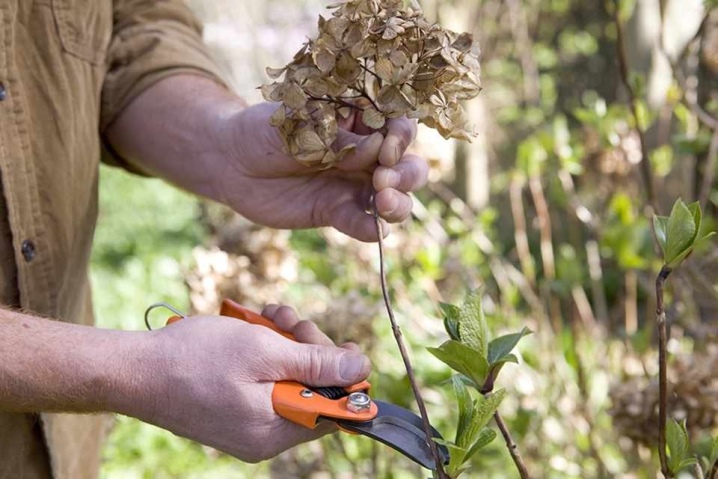
Reproduction methods
Reproduction of kalmia is a long and troublesome process. It is preferable to purchase ready-made seedlings, but if you do not have this opportunity, try one of the proposed methods.
Seeds
If you are going to grow Calcium from seed, be patient, as the plant takes a very long time to develop. You need to collect seeds in the second half of October. Before sowing, they will need stratification - exposure to low temperatures for about two months. Sowing seeds of kalmia is carried out in December. It is better to sow them in sphagnum peat: mix the seeds with sand and spread over the surface of the substrate.
Cells with crops should be outside until March, after which they are transferred indoors and covered with foil. Seedlings will appear no earlier than a month later. The sprouts need a special temperature regime: during the day the air temperature should not exceed 25-26 ° C, and at night - 10-15 ° C. In the first year, Calmia sprouts can reach a height of no more than 3-4 cm. The first fertilizers should be applied only a year after sowing. An open ground transplant is possible in 5-6 years.
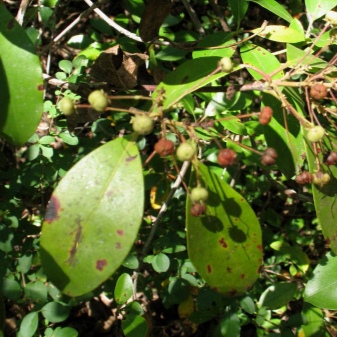
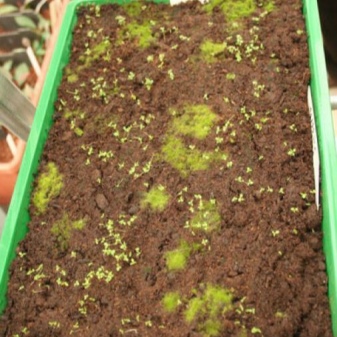
Cuttings
For reproduction of kalmiya by cuttings, it is necessary to cut off a half-lignified branch from an adult plant. It is better to do this at the beginning of June. Before planting in the ground, the cutting must be treated with a rooting stimulator. It is also necessary to prepare a special substrate for it: mix the soil with sand, peat, compost or deciduous soil. When deepening, the root collar should remain on the surface. The plant can be planted in open ground after 3-4 years.
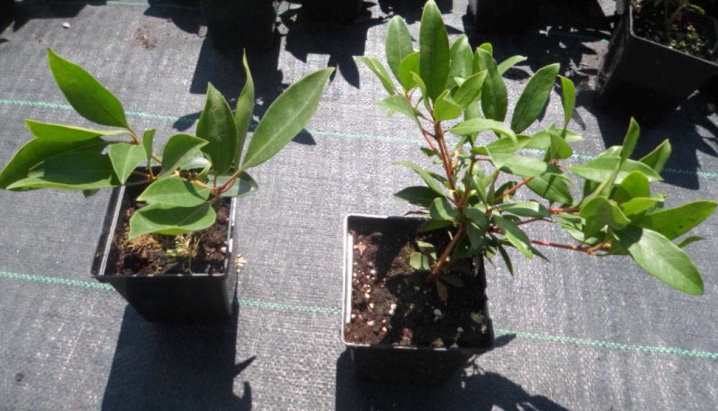
Diseases and pests
Calmia is a hardy plant. It has resistance not only to frost and drought, but also to most diseases and pests common among cultivated plants. However, it also has its weak points.
So, kalmia does not tolerate too wet, windy and cold weather at all. This can lead to late blight. With this disease, the leaves gradually dry and fall, first the lower ones, then the upper ones. Following them, the stems turn black and rot. If you notice signs of late blight on the plant, you need to remove the infected leaves and cut off the diseased stems, and pollinate the calcium with a solution of a copper-containing preparation.
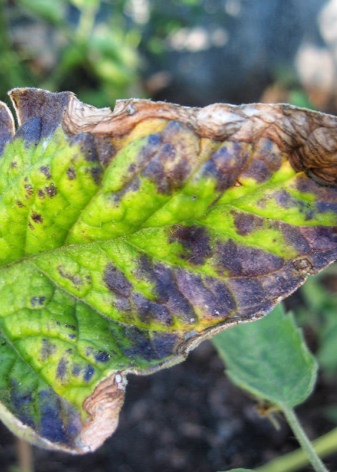
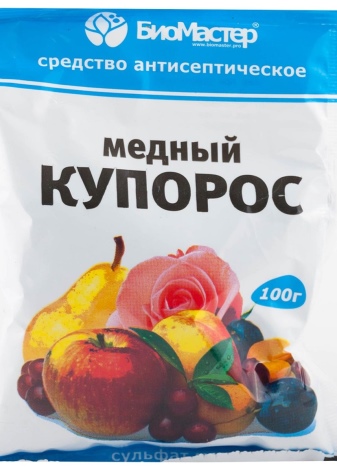
With excessive watering, the bush can hit fungal disease... In this case, you need to cancel watering until complete recovery, remove damaged parts of the plant, ensure sufficient drainage and treat the bush with fungicides.
A rarer disease for kalmia is chlorosis... When infected with chlorosis, yellow spots appear on the leaves of the plant. In such a situation, it will be necessary to add ferrous sulfate to the soil.
As for pests, they, as a rule, try to bypass the poisonous plant, so Kalmiya insects are not terrible.
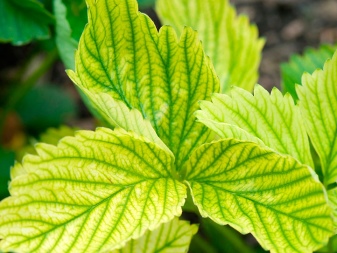

Use in landscape design
Calmia perfectly coexists with shade-loving plants that prefer a soil with high acidity. These can be conifers, as well as rhododendrons, heathers, azaleas. Calmia looks very unusual next to thuja or juniper. To create a lush and blooming garden bed, plant it next to the rosemary.
Dwarf varieties are ideal for alpine slides, rocky gardens, mixed flower beds. Often, flower growers plant calcium along paths or along the perimeter of buildings.
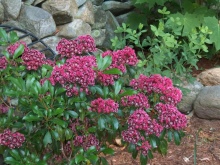
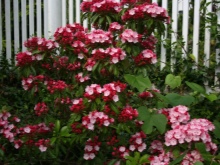
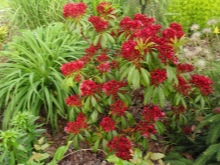
For information on how to plant calmia, see the next video.







































































































The comment was sent successfully.